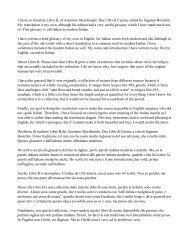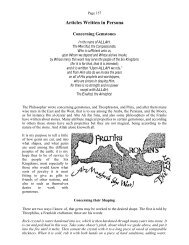How to Milk an Almond Stuff an Egg And Armor a Turnip A ...
How to Milk an Almond Stuff an Egg And Armor a Turnip A ...
How to Milk an Almond Stuff an Egg And Armor a Turnip A ...
You also want an ePaper? Increase the reach of your titles
YUMPU automatically turns print PDFs into web optimized ePapers that Google loves.
are <strong>an</strong> import<strong>an</strong>t part of traditional cooking in Irel<strong>an</strong>d, <strong>an</strong>d <strong>to</strong>ma<strong>to</strong>es in Italy. Yet both are New<br />
World vegetables; they could not have been used before 1492 <strong>an</strong>d were not in common use in<br />
Europe until a good deal later th<strong>an</strong> that.<br />
If we had no sources for medieval recipes, foreign or traditional dishes would be more suited<br />
<strong>to</strong> our feasts th<strong>an</strong> hamburgers <strong>an</strong>d french fries or Coke <strong>an</strong>d pizza; even if they are not actually<br />
medieval, they at least help create the feeling that we are no longer in our normal Twentieth<br />
Century world. Similarly, if we had no sources for period d<strong>an</strong>ce, modern folk d<strong>an</strong>ces would fit<br />
in<strong>to</strong> <strong>an</strong> event better th<strong>an</strong> disco d<strong>an</strong>cing. Since we do have sources for both period recipes <strong>an</strong>d<br />
period d<strong>an</strong>ces, there seems no good reason <strong>to</strong> use out-of-period substitutes.<br />
138<br />
Late Period <strong>an</strong>d Out of Period Foodstuffs<br />
To do period cooking, it is desirable <strong>to</strong> avoid ingredients that were not available <strong>to</strong> period<br />
cooks. “Period,” for the purposes of the SCA, is defined as pre-seventeenth century. Since most<br />
of the ingredients that are available now <strong>an</strong>d were not available during the Middle Ages came in<strong>to</strong><br />
use between 1500 <strong>an</strong>d 1700, it is not always easy <strong>to</strong> know which of them were available by the<br />
year 1600.<br />
One solution is <strong>to</strong> avoid all of the new ingredients, thus, in effect, moving the cu<strong>to</strong>ff date back<br />
<strong>to</strong> about 1492. This makes a good deal of sense as a way of learning what early cooking was like.<br />
We already know what a cuisine that includes the new foodstuffs is like–it is all around us. If we<br />
restrict ourselves <strong>to</strong> ingredients that were available throughout the Middle Ages <strong>an</strong>d the<br />
Renaiss<strong>an</strong>ce, we are likely <strong>to</strong> learn a good deal more about how period cooking differed from<br />
modern cooking th<strong>an</strong> if we include in our cooking <strong>an</strong>ything that might possibly have been in use<br />
somewhere in Europe by late December of 1600.<br />
While there is much <strong>to</strong> be said for such a voluntary restriction, nothing in the rules or cus<strong>to</strong>ms<br />
of the Society requires it of all cooks. Those who are willing <strong>to</strong> use late foodstuffs, providing they<br />
were in use by 1600, are left with the problem of determining which ones meet that requirement.<br />
This article is <strong>an</strong> attempt <strong>to</strong> do so.<br />
Corn, pota<strong>to</strong>es, cocoa, v<strong>an</strong>illa, peppers–essentially the whole list of New World foods–were<br />
used in the New World long before Columbus. Since almost all Society personae are from the<br />
Old World, it seems reasonable <strong>to</strong> limit ourselves <strong>to</strong> foods that came in<strong>to</strong> use in the Old World<br />
before 1600. A further argument in favor of doing so is that we have–so far as I know–no Aztec<br />
cookbooks, although there are descriptions by early travellers of what the natives of the New<br />
World ate <strong>an</strong>d how they prepared it; references c<strong>an</strong> be found in Fin<strong>an</strong> <strong>an</strong>d Coe. Although pota<strong>to</strong>es<br />
were eaten in South America during the fifteenth century, they were not eaten in the dishes for<br />
which we have fifteenth century recipes.<br />
Most of our period feasts are based on the cooking of a very limited part of the Old World.<br />
Almost all period cookbooks used in the Society are either Western Europe<strong>an</strong> or Islamic. For the<br />
purposes of this article I will therefore be mainly concerned with the availability of foods in<br />
Western Europe prior <strong>to</strong> the year 1600–more precisely, with the question of what foods were<br />
sufficiently well known so that they might plausibly have been served at a feast.<br />
In trying <strong>to</strong> determine which foods were available in Western Europe before 1600, I have<br />
relied on a variety of sources. They include the Oxford English Dictionary (used primarily <strong>to</strong><br />
determine when <strong>an</strong>d in what context the English name of a food was first used–hereafter OED),<br />
cookbooks, <strong>an</strong>d secondary sources including the Larousse Gastronomique (LG) <strong>an</strong>d the<br />
Encyclopedia Brit<strong>an</strong>nica, 11th edition (EB).<br />
Most of the new foodstuffs of the sixteenth <strong>an</strong>d seventeenth century came from the New<br />
World, but there were some import<strong>an</strong>t exceptions. I will start with them.





